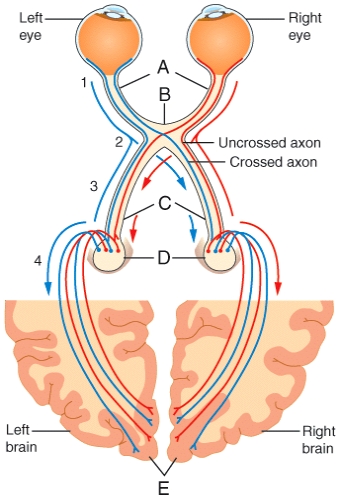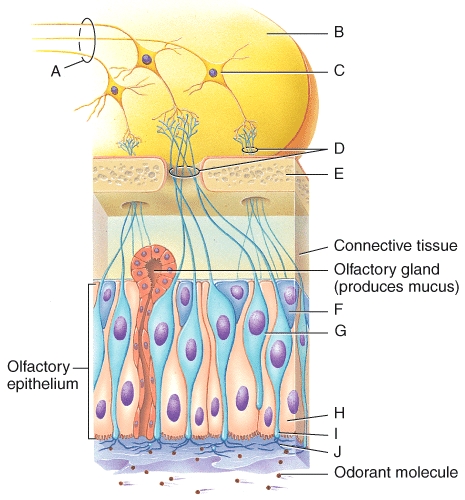A) vestibular membrane
B) tectorial membrane
C) basement membrane
D) tympanic membrane
E) basilar membrane
Correct Answer

verified
Correct Answer
verified
True/False
Perception of senses actually occurs in the cerebral cortex. In other words, perception occurs when the brain interprets the electrical impulses coming from the sensory receptors.
Correct Answer

verified
Correct Answer
verified
Multiple Choice
Touch receptors are classified as
A) mechanoreceptors
B) nociceptors
C) chemoreceptors
D) photoreceptors
E) osmoreceptors
Correct Answer

verified
Correct Answer
verified
Multiple Choice
The sensation of itch results from the stimulation of
A) corpuscles of touch
B) lamellated corpuscles
C) free nerve endings
D) proprioceptors
E) thermoreceptors
Correct Answer

verified
Correct Answer
verified
Multiple Choice
Pressure receptors that consist of a large oval-shaped, multilayered connective tissue capsule that encloses a dendrite are called
A) lamellated corpuscles
B) corpuscles of touch
C) type II cutaneous mechanoreceptors
D) hair root plexuses
E) nociceptors
Correct Answer

verified
Correct Answer
verified
True/False
Equilibrium is classified as a special sense.
Correct Answer

verified
Correct Answer
verified
True/False
Conduction deafness is often caused by damage to cochlear branch of the vestibulocochlear nerve.
Correct Answer

verified
Correct Answer
verified
Multiple Choice
Which of the following senses are NOT somatic senses?
A) touch
B) temperature
C) vision
D) muscle position
E) pain
Correct Answer

verified
Correct Answer
verified
True/False
The highest concentration of taste buds is found on filiform papillae.
Correct Answer

verified
Correct Answer
verified
Multiple Choice
Axons from the _____ neurons form the optic nerve.
A) ganglion
B) amacrine
C) bipolar
D) photoreceptor
E) horizontal
Correct Answer

verified
A
Correct Answer
verified
Multiple Choice
Which of the labeled structures in the diagram is the optic chiasm? 
A) A
B) B
C) C
D) D
E) E
Correct Answer

verified
Correct Answer
verified
Multiple Choice
Referred pain occurs because of
A) shared pathways between visceral organs and body surfaces.
B) adaptation of nerve pathways.
C) lack of myelination on pain neurons.
D) the autonomic nervous system.
E) proprioceptors found in subcutaneous tissues near the organs.
Correct Answer

verified
Correct Answer
verified
Multiple Choice
Which of the following structures is part of the vascular tunic of the eye?
A) cornea
B) sclera
C) retina
D) iris
E) optic disc
Correct Answer

verified
D
Correct Answer
verified
Multiple Choice
Which of the labeled cells in the diagram are stem cells used to continually replace old or damaged olfactory receptor cells? 
A) C
B) F
C) G
D) H
E) I
Correct Answer

verified
Correct Answer
verified
Multiple Choice
The sensors for maintaining dynamic equilibrium are located in the
A) utricle
B) saccule
C) spiral organ
D) cochlea
E) semicircular ducts
Correct Answer

verified
E
Correct Answer
verified
True/False
Short periods of exposure to loud noises are more likely to damage hair cells in the ears than long-term exposure to moderately loud sounds.
Correct Answer

verified
Correct Answer
verified
Essay
Describe the four conditions that must be satisfied for a sensation to occur.
Correct Answer

verified
1. A stimulus or change in the environme...View Answer
Show Answer
Correct Answer
verified
View Answer
Multiple Choice
The three types of cone photoreceptors found in the retina are
A) blue cones, yellow cones and red cones
B) blue cones, green cones and red cones
C) green cones, yellow cones and red cones
D) white cones, black cones and gray cones
E) amacrine neurons, bipolar neurons and ganglion neurons
Correct Answer

verified
Correct Answer
verified
True/False
Almost any excessive sensation, such as extremely loud noises or temperature extremes, can cause pain.
Correct Answer

verified
Correct Answer
verified
True/False
The middle ear is a small air-filled cavity between the eardrum and the internal ear.
Correct Answer

verified
Correct Answer
verified
Showing 1 - 20 of 102
Related Exams